Abstract
Mg2TiO4-doped Ca0.65Sr0.35Zr0.65Ti0.35O3 (CSZT) thin films with different Mg2TiO4 concentrations were deposited on the LaNiO3(LNO)/p-Si substrate using radio-frequency magnetron sputtering technology. The dielectric response of the prepared x% Mg2TiO4-CSZT thin films with frequency, voltage, and temperature was systematically studied. The tanδ and leakage current density of CSZT thin films were reduced effectively by introducing Mg2TiO4 content. The prepared 6% Mg2TiO4-CSZT thin film, due to its low loss (tanδ ~0.01 at 1 MHz), satisfied temperature stability (TCC ~−68 ppm/°C, from −55 °C to 205 °C), high withstand voltage (>160 V), and small leakage current density (about 3.34 × 10−6 A/cm2 at operating voltage of 160 V). This may be useful for capacitor materials in the next generation of portable electronic systems.
1. Introduction
Thin film capacitors are considered one of the most strategic technologies for future integral capacitors to meet the needs of miniaturized electronic equipment [1,2,3,4]. Among them, the thin film chip capacitors are recommended as candidate products in the field of handheld products. It is agreed that the dielectrics with satisfied stability in frequency, voltage, and temperature are still the key capacitor materials in the next generation portable electronic systems. Linear dielectric thin films are expected to be candidate materials for the next generation of integrated capacitor materials due to their high dielectric breakdown strength, low loss, and high stability in frequency and temperature [5]. However, traditional linear dielectrics such as SiO2, Al2O3, and Ta2O5, etc., are limited to achieve a high specific capacitance due to their low dielectric constant [6,7,8] (ε ~3.9 for SiO2, ~7 for Al2O3, ~26 for Ta2O5).
For decades, different approaches have been carried out to develop high dielectric response performance dielectric thin films. It is notable that the high dielectric permittivity of 55 was achieved in (Ca0.7Sr0.3)(Zr0.8Ti0.2)O3 thin films by Lee et al. [9]. The loss of (Ca0.7Sr0.3)(Zr0.8Ti0.2)O3 thin films was 0.015 at 1 MHz, and the leakage current density reach to 5 × 10−6 A/cm2 at voltage of 12 V [10]. The results show that the (Ca0.7Sr0.3)(Zr0.8Ti0.2)O3 thin film could be one of the most potential materials in the field of advanced capacitors. Similar research was reported in the Ca0.65Sr0.35Zr0.65Ti0.35O3(CSZT) thin films on Pt/SiO2/Si substrate by our group [11]. At room temperature, the dielectric permittivity, εr ~56.4, low tanδ ~0.003 at 1 MHz and leakage current density ~1.1 × 10−7 A/cm2 at the bias voltage of 80 V were achieved. Further investigations reveal that the loss of the CSZT thin films on p-type Si substrate is higher than that on Pt/SiO2/Si substrate and the TCC (temperature coefficient of capacitance) increased from +23.3 ppm/°C to +135 ppm/°C. For a practical integral capacitor application, p-type Si substrate is a more flexible choice. The development and improvement of the dielectric properties of CSZT thin films deposited on p-type Si substrate are necessary.
LaNiO3 (LNO) is a type of metallic oxide with a pseudo-cubic structure and is often used as a buffer layer to eliminate the interfacial dead layer between the ferroelectric thin film and the Pt electrode [12,13,14]. In addition, LNO was reported with the capability of contributing to the preferential orientation growth in lots of ABO3 thin films [15,16]. Preferential orientation has been proven as an important approach to enhance the performance of the thin films. Therefore, the LNO layer was also used in this work as a buffer layer between the CSZT and p-type silicon substrate.
In present work, the dielectric properties of Mg2TiO4-doped CSZT thin films are reported. Previous studies have reported that non-ferroelectric materials, such as MgO, MgTiO3, Mg2TiO4, Mg2SiO4, BaTi4O9, etc., are helpful to reduce the dielectric loss [17,18,19,20,21,22,23,24]. The x% Mg2TiO4-CSZT thin films were deposited on LNO/p-Si by radio frequency magnetron sputtering technology and the LNO was deposited as buffer between the CSZT thin film and the p-type silicon substrate. The work aimed to obtain a reliable high performance thin film for capacitor application which not only has a moderate dielectric permittivity and low loss, but also small TCC in wide temperature range.
2. Experiments
In this work, sol-gel process was employed to synthesis x% Mg2TiO4 doped CSZT and LNO powders, respectively. The targets used to prepare x% Mg2TiO4 doped CSZT thin film and LNO buffer layer were made of the x% Mg2TiO4 doped CSZT and LNO powders, respectively. The Ca(CH3COOH)2·2H2O (Aladdin, 98%), Sr(NO3)2 (Chron, 99.5%), Ti(OC4H9)4 (Aladdin, 98.5%), Zr(NO3)4·5H2O (Chron, 99.28%), and Mg(CH₃COO)₂·4H2O (Greagent, 99.0%), weighted according to the x mol% Mg2TiO4 - Ca0.65Sr0.35Zr0.65Ti0.35O3 stoichiometry, were used to synthesize x% Mg2TiO4 doped CSZT precursor sols. The LaNiO3 stoichiometric La(NO3)3·6H2O (Chron, 99.00%) and Ni(CH₃COO)₂ ·4H2O (Chron, 98.00%) were weighted to synthesize LNO precursor sol. After the sols changed into wet gels, the wet gels were dried into xerogels by rotating evaporation at 80 °C. Then, the x% Mg2TiO4 doped CSZT xerogels and LNO xerogel were calcined 3 h at 1350 °C and 800 °C to form the x% Mg2TiO4 doped CSZT and LNO ceramic powdesr, respectively. Here, x% = 0, 2, 4, 6, and 8 in mol%, respectively. The deposition process of LNO buffer layer and x% Mg2TiO4-CSZT thin films were carried out on p-type Si substrates using a Radio Frequency Magnetron Sputtering system (RFMS, Sky Technology Development, JGP560D, Shenyang, China). The specific process parameters of x%-Mg2TiO4 CSZT films and LNO buffer layer are shown in Table 1. All the prepared thin films were conventional thermal annealed (CTA) in air at 700 °C for 180 min to obtain well-crystallized grains. A 0.3 mm diameter Au topped circular electrode was prepared on the CSZT layer by electroplating.

Table 1.
The sputtering process parameters of x% Mg2TiO4-CSZT thin films and LNO buffer layer.
The crystal phase of x% Mg2TiO4-CSZT thin films were measured using X ray-diffraction (DX-2700, Dandong, China) with Cu Kα radiation obtained under a Ni filter (Range: 2θ = 20°~70°, Step angle: 0.2°/step, Sampling time: 0.5 s/step, Tube voltage: 40 kV, Tube current: 30 mA). The thickness of the prepared thin films was investigated by field emission scanning electron microscope (Thermo Scientific, Helios G4 UC, Waltham, MA, USA) with an accelerating voltage of 15 kV. The capacitance–frequency curve (C-f curve) from 10 kHz to 1 MHz and the capacitance-voltage curve (C-V curve) measured by using a multi-frequency Inductance-Capacitance-Resistance (LCR) meter (Agilent, HP4294A, Santa Clara, CA, USA), for C-V curve measurement, the thin films were measured with 100 kHz and a dielectric spectrum oscillation voltage of 500 mV at room temperature. The leakage current density of the prepared thin films was measured by using a Radiant Precision Workstation (Radiant, Precision Multiferroic II, Albuquerque, NM, USA) at room temperature. The temperature-related properties were carried on a heating probe stage (Linkam, HFS600E-PB4, Surrey, UK) with a temperature rising rate of 3 °C/min.
3. Results and Discussion
The XRD patterns of x% Mg2TiO4-CSZT thin films measured at room temperature are shown in Figure 1. The thin films were deposited on LNO/p-Si and annealed at 700 °C for 3 h. All the x% Mg2TiO4-CSZT thin films show the significant (l0l)-preferred orientation growth characteristic (according to PDF#35-0645). Clearly, the (l0l)-preferred orientated LNO buffer layer plays a key role here. Among them, the 0%, 2%, and 4%Mg2TiO4-CSZT thin film show the only perovskite phase. The 8% Mg2TiO4-CSZT thin film displays clear second phase diffraction peaks at ~43° and ~74° (marked with •). The two peaks are associated with the diffraction peaks of MgO (according to PDF# 87-0653). It suggests that Mg2TiO4-CSZT is limited solid solution and small amount of MgO separated out from the 8%Mg2TiO4 doped CSZT solid solution [25]. Furthermore, compared with pure CSZT thin film sample, the orientation of LNO buffer layers are weakened due to the growth of Mg2TiO4 doped CSZT thin film on them. As a result, the LNO (021) diffraction peaks could be observed in the Mg2TiO4 doped CSZT thin film XRD patterns. As a close observation, all the LNO (101) and (202) peaks (sited ~23°and ~47°) of those Mg2TiO4-CSZT thin film samples shift to left (see Figure 1). It is likely that the Mg2TiO4 doped CSZT interpenetrated the LNO layer at the interface, resulting in the orientation degree of LNO reducing, and more LNO diffraction peaks could be observed.
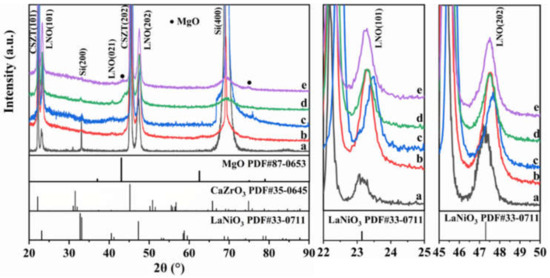
Figure 1.
X-ray diffraction pattern of x% Mg2TiO4-CSZT thin films in the 2θ range of 20–90°. (a) x = 0; (b) x = 2; (c) x = 4; (d) x = 6; (e) x = 8.
Figure 2 shows cross-section morphology of the prepared thin films by SEM micrographs. All the thin films show dense, crack free, and uniform microstructure. The columnar crystalline grain of x% Mg2TiO4-CSZT grown on the LNO layer is clearly visible. Additionally, it could be noticed that the thicknesses of the thin films are different even though they were prepared in the same time. The thicknesses and growth rates of the thin films were listed in Table 2. The growth rate of the x% Mg2TiO4-CSZT thin films increases significantly with the increase in the Mg2TiO4 content when the content is more than 2%.
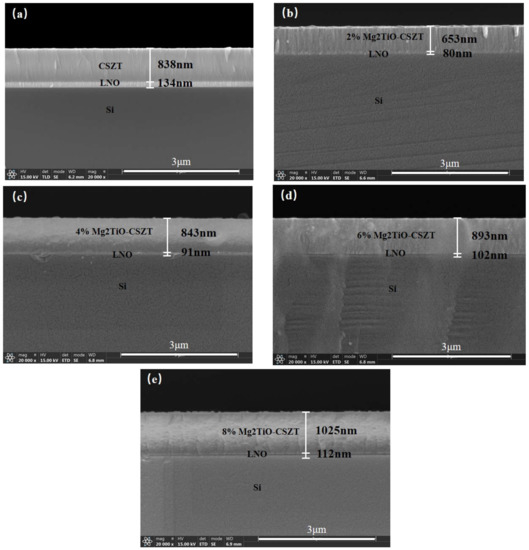
Figure 2.
The cross-section scanning electron microscope (SEM) micrographs of the x% Mg2TiO4-CSZT/LNO thin films. (a) x = 0; (b) x = 2; (c) x = 4; (d) x = 6; (e) x = 8.

Table 2.
The thickness and the growth rate of the x% Mg2TiO4-CSZT/LNO thin films.
The dependence of DC voltage and frequency to dielectric permittivity and dielectric loss were measured at room temperature and shown in Figure 3. Both dielectric permittivity-frequency curve and the dielectric permittivity-DC voltage curve display the frequency independent (see Figure 3a) and operating voltage independent (see Figure 3b) characteristics for all the prepared thin films. The results indicate that all the prepared thin films behave with a typical linear dielectric response, even the Mg2TiO4 doped CSZT thin films. Additionally, small amounts of Mg2TiO4 leads to a small increase in dielectric permittivity; the dielectric permittivity will reduce if the Mg2TiO4 content is higher than 4%.
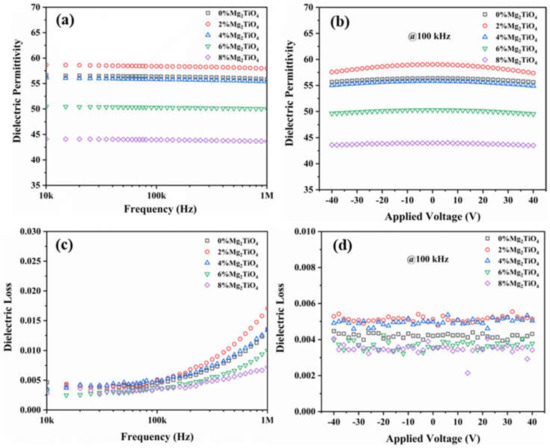
Figure 3.
The dielectric properties of the prepared thin films at room temperature. (a,b) are the dielectric permittivity of x% Mg2TiO4-CSZT thin films as a function of frequency and DC voltage, respectively; (c,d) are the dielectric loss of x% Mg2TiO4-CSZT thin films as a function of frequency and DC voltage, respectively.
Figure 3c shows the dielectric loss-frequency curve of all the thin films. The dielectric loss of all the thin films is no mre than 0.0175 at 1 MHz. Figure 3d shows the DC field dependence of the dielectric loss (tanδ) of all the thin films. The measured signal is an AC signal with an amplitude of 0.5 V and a frequency of 100 kHz. The DC voltage ranges from −40 V to 40 V. The tanδ of all the thin films is no more than 0.006 in the measured range. The tanδ valus change rarely with the increase in voltage value, indicating the typical linear dielectric response feature which is consistent with the result of Figure 3b. For the thin film x = 6%, the dielectric permittivity εr is around 50 at 1 MHz and tanδ is ~0.01 at 1 MHz which is lower than reported reference [10].
The dielectric response-temperature curve of x% Mg2TiO4-CSZT thin films is shown in Figure 4. The measured temperature ranges from −55 °C to 205 °C. Compared with the 0% Mg2TiO4–CSZT thin film, the dielectric permittivity of 6% Mg2TiO4-CSZT thin film shows the smallest temperature changing rate, the TCC value, ~−68 ppm/°C among all the prepared thin films. The TCC values of all the thin films ranging from −55 °C to 205 °C are around −135 ppm/°C, −98 ppm/°C, −78 ppm/°C, −68 ppm/°C, and −97 ppm/°C for x = 0, 2, 4, 6, and 8, respectively. The results reveal that moderate Mg2TiO4 are helpful to improve dielectric response-temperature characteristic. Meanwhile, the tanδ of the x% Mg2TiO4-CSZT thin films increase with the incerasing of temperature mildly below 100 °C, then the increase becomes significant and reaches 0.02 at 160 °C. For the thin films with x = 6 and 8, the tanδ values are still smaller than 0.01 at 120 °C. Compared with the other linear dielectrics reported in the previous work (see Figure 5), 6% Mg2TiO4-CSZT thin film show ideal dielectric permittivity temperature stability, TCC value is second only to that of SiO2. It is noticed that 6% Mg2TiO4-CSZT thin film keeps small temperature changing rate, TCC value (~−68) in a wide temperature range (−55 °C~205 °C).

Figure 4.
The dielectric response temperature characteristics of x% Mg2TiO4-CSZT thin films in the range of −55~205 °C.
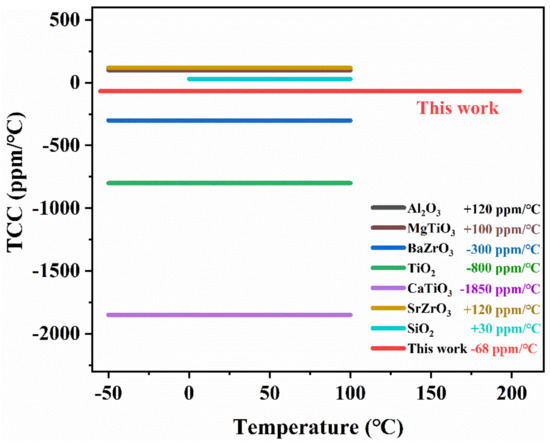
Figure 5.
A TCC value comparison of this work and other reported linear dielectrics. Data are from references [26,27].
Figure 6 shows the leakage current density of the prepared x% Mg2TiO4-CSZT thin films at room temperature. The measured voltage ranges from −160 V to 160 V. At the voltage of 160 V, 8% Mg2TiO4-CSZT thin film has the lowest leakage current density (1.61 × 10−6 A/cm2 at ±160 V), the leakage current density of 6% Mg2TiO4-CSZT thin film is 3.34 × 10−6 A/cm2 at ±160 V) which is lower than reported in reference [9] and [10]. The results indicate that the proper Mg2TiO4 introduction can decrease the leakage currents effectively.
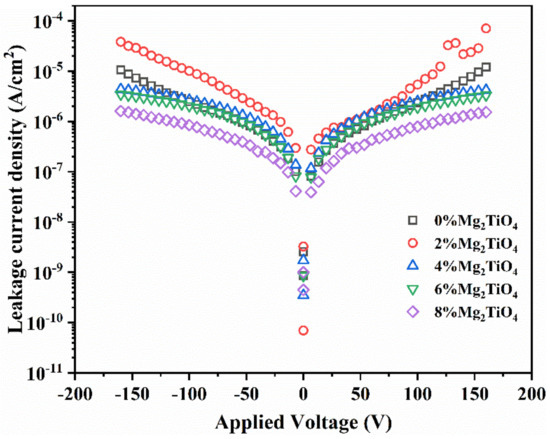
Figure 6.
The leakage current density of x% Mg2TiO4-CSZT thin films as a function of the applied bias voltage at room temperature.
4. Conclusions
Investigations on the dielectric properties of x% Mg2TiO4-doped Ca0.65Sr0.35Zr0.65Ti0.35O3 thin films showed that the addition of Mg2TiO4 can effectively reduce the dielectric loss and leakage current density of CSZT thin films. The prepared 6% Mg2TiO4-CSZT thin film exhibits a satisfying comprehensive performance of εr ~50.00 at 1 MHz, tanδ ~0.01 at 1 MHz, TCC ~−68 ppm/°C from −55 °C to 205 °C, and about 3.34 × 10−6 A/cm2 at operating voltage of 160 V compared with the reported linear dielectrics given in reference [26,27], and thus could be a suitable capacitor material in the next generation portable electronic systems.
Author Contributions
Conceptualization, P.Y.; methodology, Y.L.; investigation, Y.L., B.H. and X.C.; data curation, Y.L.; writing—original draft preparation, Y.L.; writing—review and editing, P.Y.; project administration, P.Y.; funding acquisition, P.Y. All authors have read and agreed to the published version of the manuscript.
Funding
This research was funded by the National Natural Science Foundation of China under grant No. u1601208 and No. 51802204, China.
Institutional Review Board Statement
Not applicable.
Informed Consent Statement
Not applicable.
Data Availability Statement
Not applicable.
Acknowledgments
We appreciate Wang Hui from the Analytical and Testing Center of Sichuan University for her help with SEM characterization.
Conflicts of Interest
The authors declare no conflict of interest.
References
- Bhattacharya, S.K.; Tummala, R.R. Next generation integral passives: Materials, processes, and integration of resistors and capacitors on PWB substrates. J. Mater. Sci. Mater. Electron. 2000, 11, 253–268. [Google Scholar] [CrossRef]
- Rahayu, R.; Kang, M.-G.; Do, Y.-H.; Hwang, J.-H.; Kang, C.-Y.; Yoon, S.-J. Electrical characteristics of Ba0.6Sr0.4TiO3 Thin-film chip capacitors for embedded passive components. IEEE Electron Device Lett. 2013, 34, 99–101. [Google Scholar] [CrossRef]
- Tuichai, W.; Danwittayakul, S.; Maensiri, S.; Thongbai, P. Investigation on Temperature stability performance of giant permittivity (In+Nb) in co–doped TiO2 ceramic: A crucial aspect for practical electronic applications. RSC Adv. 2016, 6, 5582–5589. [Google Scholar] [CrossRef]
- Chen, X.; Mo, T.; Huang, B.; Liu, Y.; Yu, P. Capacitance properties in Ba0.3Sr0.7Zr0.18Ti0.82O3 Thin films on silicon substrate for thin film capacitor applications. Crystals 2020, 10, 318. [Google Scholar] [CrossRef]
- Chen, X.; Zhang, Y.; Xie, B.; Huang, K.; Wang, Z.; Yu, P. Thickness-dependence of growth rate, dielectric response, and capacitance properties in Ba0.67Sr0.33TiO3/LaNiO3 hetero-structure thin films for film capacitor applications. Thin Solid Film. 2019, 685, 269–274. [Google Scholar] [CrossRef]
- Groner, M.D.; Elam, J.W.; Fabreguette, F.H.; George, S.M. Electrical characterization of thin Al2O3 films grown by atomic layer deposition on silicon and various metal substrates. Thin Solid Film. 2002, 413, 186–197. [Google Scholar] [CrossRef]
- Acquaviva, S.; Giorgi, M.L.D.; Elia, L.M.F.; Leggieri, G.; Luches, A.; Martino, M.; Zocco, A. Laser deposition of thin SiO2 and ITO films. Appl. Surf. Sci. 2000, 168, 244–247. [Google Scholar] [CrossRef]
- Chaneliere, C.; Autran, J.L.; Devine, R.A.B.; Balland, B. Tantalum pentoxide (Ta2O5) thin films for advanced dielectric applications. Mater. Sci. Eng. 1998, R22, 269–322. [Google Scholar] [CrossRef]
- Baek, E.; Yun, Y.S.; Kim, H.K.; Lee, S.H.; Lee, S.G.; Im, I.H.; Lee, Y.H. Effect of post-annealing on (Ca0.7Sr0.3)(Zr0.8Ti0.2)O3 films on Pt and Cu substrates fabricated by aerosol deposition. J. Nanosci. Nanotechnol. 2015, 15, 8478–8483. [Google Scholar] [CrossRef]
- Lee, S.H.; Kim, H.K.; Yun, Y.S.; Lee, S.G.; Lee, Y.H. Dielectric properties of (Ca0.7Sr0.3)(Zr0.8Ti0.2)O3 thin films with different deposition temperatures. J. Nanosci. Nanotechnol. 2015, 15, 2330–2332. [Google Scholar] [CrossRef]
- Huang, B.; Liu, Y.; Ji, H.; He, Q.; Chen, X.; Yu, P. Enhanced temperature stable dielectric response and high dielectric strength observed in (CaZr)0.65(SrTi)0.35O3 thin film. J. Alloy Compd. 2021, 876, 160232. [Google Scholar] [CrossRef]
- Zhai, J.; Yao, X.; Xu, Z.; Chen, H. Ferroelectric properties of PbxSr1−xTiO3 and its compositionally graded thin films grown on the highly oriented LaNiO3 buffered Pt/Ti/SiO2/Si substrates. J. Appl. Phys. 2006, 100, 034108. [Google Scholar] [CrossRef]
- Cheng, Z.X.; Wang, X.L.; Kimura, H.; Ozawa, K.; Dou, S.X. La and Nb codoped BiFeO3 multiferroic thin films on LaNiO3/Si and IrO2/Si substrates. Appl. Phys. Lett. 2008, 92, 092902. [Google Scholar] [CrossRef] [Green Version]
- Tomczyk, M.; Mahajan, A.; Tkach, A.; Vilarinho, P.M. Interface-based reduced coercivity and leakage currents of BiFeO3 thin films: A comparative study. Mater. Des. 2018, 160, 1322–1334. [Google Scholar] [CrossRef]
- Gao, Y.; Yuan, M.; Sun, X.; Ouyang, J. In situ preparation of high quality BaTiO3 dielectric films on Si at 350–500 °C. J. Mater. Sci. Mater. Electron. 2016, 28, 337–343. [Google Scholar] [CrossRef]
- Meng, X.J.; Ma, Z.X.; Sun, J.L.; Bo, L.X.; Ye, H.J.; Guo, S.L.; Chu, J.H. Highly oriented PbZr0.3Ti0.7O3 thin film on LaNiO3-coated Si substrate derived from a chemical solution technique. Thin Solid Film. 2000, 372, 271–275. [Google Scholar] [CrossRef]
- Sengupta, L.C.; Sengupta, S. Breakthrough advances in low loss, tunable dielectric materials. Mater. Res. Innov. 1999, 2, 278–282. [Google Scholar] [CrossRef]
- Sengupta, L.; Warwick, M. Ceramic Ferroelectric Composite Material–BSTO–Magnesium Based Compound. U.S. Patent 5,635,434, 3 June 1997. [Google Scholar]
- Chen, Y.; Dong, X.-L.; Liang, R.-H.; Li, J.-T.; Wang, Y.-L. Dielectric properties of Ba0.6Sr0.4TiO3/Mg2SiO4/MgO composite ceramics. J. Appl. Phys. 2005, 98, 064107. [Google Scholar] [CrossRef]
- Yan, L.; Chen, L.F.; Tan, C.Y.; Ong, C.K.; Anisur Rahman, M.; Osipowicz, T. Ba0.1Sr0.9TiO3-BaTi4O9 composite thin films with improved microwave dielectric properties. Eur. Phys. J. B Condens. Matter Complex Syst. 2004, 41, 201–205. [Google Scholar] [CrossRef]
- Jain, M.; Majumder, S.B.; Katiyar, R.S.; Agrawal, D.C.; Bhalla, A.S. Dielectric properties of sol–gel-derived MgO: Ba0.5Sr0.5TiO3 thin-film composites. Appl. Phys. Lett. 2002, 81, 3212–3214. [Google Scholar] [CrossRef]
- Jain, M.; Majumder, S.B.; Yuzyuk, Y.; Katiyar, R.S.; Bhalla, A.S.; Miranda, F.A.; Van Keuls, F.W. Dielectric properties and leakage current characteristics of sol-gel derived (Ba0.5Sr0.5)TiO3: MgTiO3 thin film composites. Ferroelectr. Lett. 2003, 30, 99–107. [Google Scholar] [CrossRef]
- Chou, X.; Zhai, J.; Yao, X. Dielectric tunable properties of low dielectric constant Ba0.5Sr0.5TiO3–Mg2TiO4 microwave composite ceramics. Appl. Phys. Lett. 2007, 91, 122908. [Google Scholar] [CrossRef]
- Gao, L.; Zhai, J.; Yao, X.; Xu, Z. MgTiO3 and Ba0.60Sr0.40Mg0.15Ti0.85O3 composite thin films with promising dielectric properties for tunable applications. J. Am. Ceram. Soc. 2008, 91, 3109–3112. [Google Scholar] [CrossRef]
- Jia, Q.; Ji, H.; Li, X.; Liu, S.; Jin, Z. Sinterability and dielectric properties of Ba0.55Sr0.4Ca0.05TiO3–CaTiSiO5–Mg2TiO4 composite ceramics. J. Alloy Compd. 2011, 509, 10155–10160. [Google Scholar] [CrossRef]
- Kell, R.C.; Greenham, A.C.; Olds, G.C.R. High-permittivity temperature-stable ceramic dielectrics with low microwave loss. J. Am. Ceram. Soc. 1973, 56, 352–354. [Google Scholar] [CrossRef] [Green Version]
- Sato, S.; Sato, A.; Okamoto, E. An SiO2-Ta2O5 thin film capacitor. IEEE Trans. Parts Hybrids Packag. 1973, 9, 161–166. [Google Scholar] [CrossRef]
Publisher’s Note: MDPI stays neutral with regard to jurisdictional claims in published maps and institutional affiliations. |
© 2022 by the authors. Licensee MDPI, Basel, Switzerland. This article is an open access article distributed under the terms and conditions of the Creative Commons Attribution (CC BY) license (https://creativecommons.org/licenses/by/4.0/).